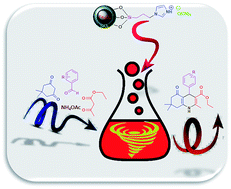Retracted Article: Synthesis and characterization of novel silica-coated magnetic nanoparticles with tags of ionic liquid. Application in the synthesis of polyhydroquinolines
Abstract
A novel, green and recoverable silica-coated magnetic nanoparticle immobilized ionic liquid, was designed, synthesized and fully characterized using IR, X-ray diffraction patterns (XRD), scanning electron microscopy (SEM), transmission electron microscopy (TEM), and thermogravimetry (TG) and vibrating sample magnetometer (VSM) analysis. The resulting nanomagnetic catalyst has been successfully used for the condensation of various aromatic aldehydes, dimedone, β-ketoester and ammonium acetate under solvent free and mild conditions to yield polyhydroquinoline derivatives in good to excellent yields. The described catalyst was recycled and reused without any significant changes in the yield and the reaction time.


 Please wait while we load your content...
Please wait while we load your content...